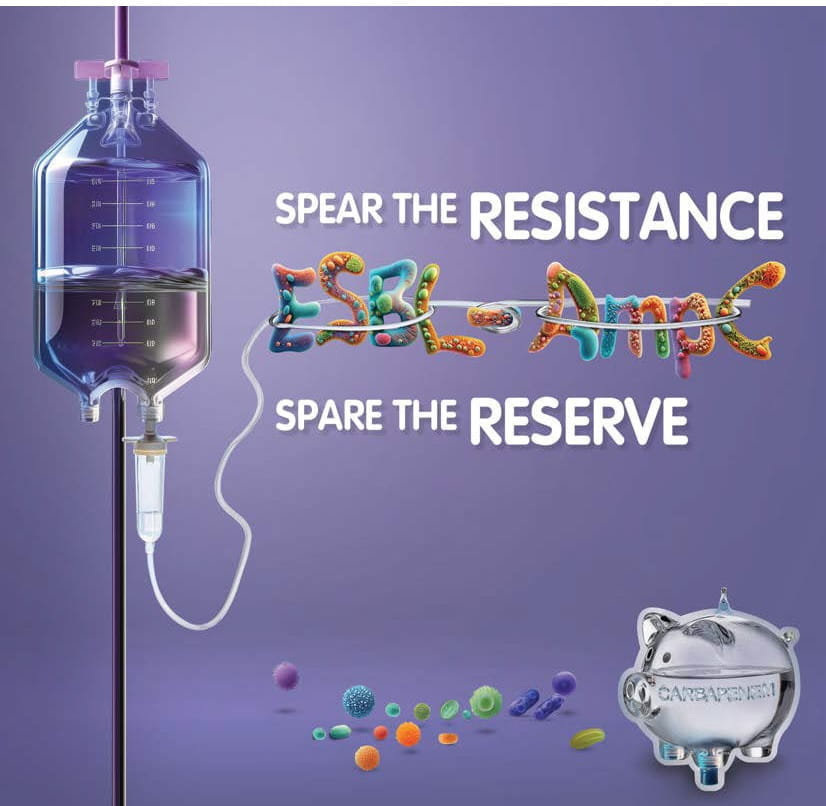Optimising Antibiotic Therapy in VAP
Speaker: Dr Pinyo Rattanaumpawan, Thailand
Introduction:
The implementation of antimicrobial stewardship in optimising antibiotic therapy in Ventilator-Associated Pneumonia (VAP) mainly includes three strategies:
-
Diagnostic Strategies for VAP Optimization
-
Inhaled Antibiotic Therapy
-
Shortening Antibiotic Duration
-
Diagnostic Strategies for VAP Optimization:
-
Gram stain-guided therapy (Japan multicentre RCT) - The following results were seen when gram stain guided therapy was compared to guideline based empiric therapy which included anti-MRSA and anti-Pseudomonal agents
-
Gram stained guidance achieved a higher clinical response (76.7%) as compared to guideline based empiric therapy (71.8%) with a p-value of <0.001
-
Gram stain guidance reduced unnecessary use of broad-spectrum agents and it also increased escalation slightly (7%) due to initial under treatment.
-
Mortality and length of stay outcomes were similar across arms
-
Delayed antibiotics in non-severe VAP- A study was conducted with 87 patients, where instead of starting antibiotics right away, they waited for culture results (from respiratory samples) to confirm infection before starting with antibiotics. The following observations were made:
-
There were no adverse effects seen on 28-day mortality or ventilation duration
-
This supported a cautious delay in selected cases
-
Multiplex PCR panels (Unyvero vs. BioFire)
-
Unyvero and BioFire offer rapid pathogen and resistance gene detection. It was seen that BioFire had faster Turnaround time (TAT) of 1 hour 15 minutes when compared to Unyvero with a TAT of 5 hours.
-
In UK multicenter evaluation it was concluded that BioFire detected more additional pathogens (47.9%) but had a slightly lower concordance (71.3%) as compared to Unyvero (74.8%).
-
In the INHALE WP3 randomized trial it was observed that Biofire used increased appropriate antibiotic prescribing when compared to Unyvero (76.5% vs. 60%), however there was no mortality benefit and BioFire failed to demonstrate non-inferiority in clinical cure.
-
Inhaled Antibiotic Therapy:
-
The following are the key factors to be considered for inhaled antibiotic therapy.
-
Nebulizer selection and placement are critical for effective drug delivery
-
Vibrating mesh nebulizers are considered to be optimal; they create small particle size, cause minimal heating to the drug, but they are more expensive.
-
The drug properties also matter. The inhaled agents should be hydrophobic, pH balanced and non-irritating.
-
Common Agents include the following:
-
Amikacin: Only the preservative-free inhaled formulations are suitable and it is seen to have high epithelial lining fluid (ELF) concentrations.
-
Colistin: Given as Inhaled colistimethate sodium and requires in-vivo conversion and is seen to have high-patient variability in ELF levels.
-
Clinical Impact
-
Studies suggest that inhaled antibiotics may reduce VAP incidence and IV antibiotic usage but there was no proven survival benefit seen.
-
IDSA 2016 guidelines recommend inhaled + systemic antibiotics only in Multidrug-Resistant (MDR) cases where the options are limited.
-
ESCMID 2017 and IDSA 2021 guidelines do not recommend routine use.
-
Shortening Antibiotic Duration
-
Despite having evidence, longer durations (10-14 days) are often prescribed based on outdated practices. Key findings of Randomised Control Trials (RCTs) includes the following:
-
2003 French RCT compared 8 days and 15 days of antibiotics. Though it was found that 8-days was non-inferior, infections caused by Pseudomonas aeruginosa had slightly higher relapse rates with the shorter course.
-
LIFEGUARD VAP (Asia) trail compared individualized short courses (3-7 days) and standard courses (≥8 days). It was observed that there was no difference in 60-day mortality or recurrence, even in MDR infections. Shorter antibiotic duration led to fewer adverse effects.
Conclusion:
-
Rapid diagnostics expedited identification, but required expert interpretation to prevent misuse.
-
Inhaled antibiotics may have shown to improve microbiological cure, but do not improve survival.
-
Short courses (5-7 days) were seen to be safe and effective, even in MDR VAP.
-
It was seen that it is essential to distinguish colonization (harmless presence of bacteria) from true infection. Antibiotics should be avoided in treating non-infectious diseases like Congestive Heart Failure (CHF), as they may cause harm.
ESCMID Global, April 11-15, 2025, Vienna




